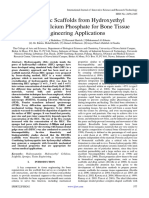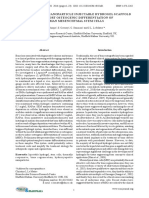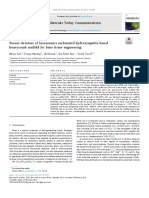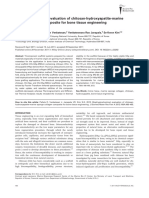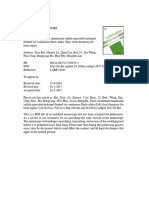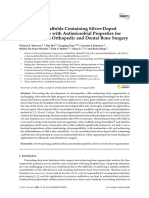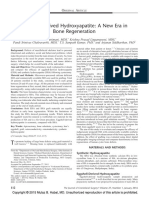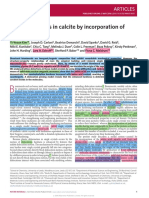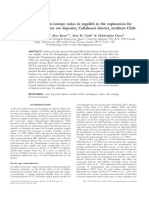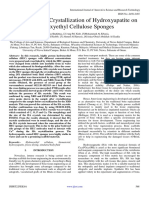Professional Documents
Culture Documents
A Study On The Crystallization of Hydroxyapatite On Hydroxyethyl Cellulose Sponges
Original Title
Copyright
Available Formats
Share this document
Did you find this document useful?
Is this content inappropriate?
Report this DocumentCopyright:
Available Formats
A Study On The Crystallization of Hydroxyapatite On Hydroxyethyl Cellulose Sponges
Copyright:
Available Formats
Volume 7, Issue 2, February – 2022 International Journal of Innovative Science and Research Technology
ISSN No:-2456-2165
A Study on the Crystallization of Hydroxyapatite on
Hydroxyethyl Cellulose Sponges
[1]Fathima Shahithaa, [2] Ang Pei Xinb, [3]Mohammed Al-Sibania,
[4] Ab. Rahim, Mohd Hasbib, [5] Ahmed Al Harrasic, [6]Asiya Obaid Abdallah Al Saadia
The College of Arts and Sciences, Department of Biological Sciences and Chemistry, University of Nizwa Initial Campus, Birkat
Al Mouz, P.O. Box 33, PC 616, Nizwa, Sultanate of Oman, bFaculty of Industrial Sciences & Technology, Universiti Malaysia
Pahang, Lebuhraya Tun, Razak, 26300 Gambang, Kuantan, Pahang, Malaysia, bNatural and Medical Sciences Research Center,
University of Nizwa Initial Campus, Birkat Al Mouz, P.O. Box 33, PC 616, Nizwa, Sultanate of Oman.
Abstract:- In this research, highly porous hydroxyethyl other bone transport methods. These are some of the common
cellulose (HEC) sponges with different concentrations standard treatments, but they are having some inherent
were prepared and cross linked by which the HEC sponges limitation as well. For instance, the defect size and viability of
were changed from soluble into insoluble from in water the host bed will affect the bone grafting as it is avascular and
which also enhanced its biodegradability. After the cross- dependent on diffusion. Besides, it may be problematic
linking process, hydroxyapatite (HA) crystals were formed especially in large defects as the body may reabsorb the grafts
on the HEC sponges through the crystallization process by before the osteogenesis is completed. For vascularized bone
using 20X simulated body fluid solution (SBF) solution, transplant, highly specialized technical expertise is needed for
and the product was characterized by using FTIR, optical this sophisticated operation, the operating time needs to be
microscopy, FESEM with EDX, and XRD. From the FTIR prolonged, and the bone transplanted may be not large enough
results obtained, the presence of acetal group at the to match the big defect of the bone for immediate
wavenumbers around 1022.20-1025.83 cm-1 had showed biomechanical stability (Philips and Nather, 2001).
the cross-linking process was succeeded. FTIR results after Furthermore, the donor tissue for autografts is always scarce,
the crystallization showed peak of PO43- and CO32- which and significant morbidity of the donor site which usually
indicate the presence of HA crystals. This result was associated with infection, hematoma and pain may be occurred.
confirmed by using XRD and FESEM-EDX. There were
extra peaks shown in the sample after crystallization Hence, bone tissue engineering is developed and applied
compared to the sample before crystallization for the XRD as an alternative way for the traditional bone replacement
analysis. This can proved the existence of the HA crystals. method (Choong et al., 2011). The highly porous scaffold
Further confirmation was done by using FESEM-EDX, biomaterial is mainly used in the tissue engineering.
and the element composition of HA crystals was revealed, Biomaterial can be defined as implanted materials which can
which consisted of C, O, P and Ca. The morphology and replace or treat any tissues, organ or function of our body
the size of the HA crystals was determined by using (Hollinger, 2012). It is used as a temporary matrix for the
FESEM. From the results obtained, it showed that HA growth of bone which offers a specific environment and
crystals synthesized were in round shape, and the size of structure for tissue development. Tissue engineering has
the HA crystals increased when the concentration of the utilized the growth factors, scaffolds and mesenchymal stem
HEC sponges increased. This is due to the polar hydroxyl cells for the bone regeneration process. Bone scaffolds
side groups of the HEC molecules tend to interact with produced with various compositions and structures has been
Ca2+ during the HA crystallization process. The developed successfully by scientists in different methods
hydroxyapatite coated HEC sponges were highly stable in (Matassi et al., 2011). The scaffold will combine with the body
water and can be a promising scaffold material. cell to help in regenerating the damaged tissues (O'Brien,
2011).
Keywords:- Hydroxyethyl cellulose, biomaterial,
hydroxyapatite, freeze drying, simulated body fluid Hydroxyappatite (HA) with the chemical formula of
Ca10(PO4)6(OH)2 is acted as the most significant biomineral
I. INTRODUCTION and inorganic component in the bone tissue of the vertebrates
(Chen et al., 2012). The high resemblance of HA with the
Nowadays, intense research is being carried out to inorganic component of bone matrix has encouraged the
develop scaffolds for tissue engineering in an environmentally researchers to study on the synthetic HA. HA has high
friendly way by green chemistry approach. According to Burg biocompatibility with the soft tissues like gums, muscle and
et al. (2000), the development of bone tissue engineering as an skin. This characteristic makes it to be a suitable material for
alternative has brought some advantages compared to the the orthopedic and dental implants compared to traditional
traditional ways of bone replacement such as allografts and allografts and metallic implants. Synthetic HA has been
autografts, vascularised grafts of the fibula or iliac crest and applied widely in the repairment and augmentation of bone,
IJISRT22FEB261 www.ijisrt.com 568
Volume 7, Issue 2, February – 2022 International Journal of Innovative Science and Research Technology
ISSN No:-2456-2165
other than as the implant’s coating and fillers in bone or teeth II. EXPERIMENTAL SECTION
(Zhou and Lee, 2011).
A. Materials
Bones and teeth are basically made up of HA and Hydroxyethyl cellulose (HEC) was purchased from
collagen fibers, which are organic/inorganic composites. Nacalai Tesque, Japan. Glutaraldehyde, grade II, 25% in H2O
Therefore, in bone tissue engineering, HA/polymer was purchased from Sigma-Aldrich, USA. Phosphoric acid
composites are applied extensively as they are chemically was purchased from R&M Chemical, UK. Analytical reagent
similar to the natural bone. The interaction and bonding grade acetone was purchased from Bendosen. Among the
between inorganic and organic phases have to be strong in chemicals used for preparing the SBF solution, sodium
order to possess a good mechanical property. In the living chloride (NaCl) was purchased from Merck KGaA, Germany,
organisms, the bone cell and tissues starting from nano-blocks calcium chloride dehydrate, (CaCl2.2H2O) was purchased
can combine to form self-assembled biomaterials under a from Fisher Chemical, UK, sodium bicarbonate (NaHCO3),
controlled organic matrix. Therefore, in the process of potassium chloride (KCl), magnesium chloride hexahydrate
synthesizing the synthetic HA, a matrix mediated (MgCl2.6H2O) and sodium dihydrogen phosphate
mineralization is very important as it can mimic the structure (NaH2PO4.H2O) were purchased from Sigma-Aldrich, USA.
of the natural bone and the environment of the growth of Deionized water was used throughout the research for
natural bone tissues (Li et al., 2010). Organic matrix can help preparing all the solutions and cleaning the glassware.
in controlling the HA formation include the nucleation and
crystal growth as well as the morphology of HA (Sinha et al., B. Experimental
2009).
Preparation of the Hydroxyethyl Cellulose Solution
HEC is a type of non-ionic polymer which is soluble in Prior to the experiment, all the glassware were washed
water. In order to strengthen the mechanical properties, the and cleaned with soap and deionized water to prevent
structure of HEC sponges is modified by cross-linking to contamination of the sample. The HEC solution with five
remove the water soluble characteristics. There are numerous different concentrations: 1 wt%, 3 wt%, 5 wt%, 7 wt% and 10
vitro studies had been done on the affection and wt% were prepared by dissolving 1 g, 3 g, 5 g, 7 g and 10 g
biocompatibility of the HA within the synthetic polymers like HEC powder with 100 mL of deionized water in five separated
HEC on the biological function of bone-associated cells, and beakers. Deionized water was used as the solvent it has no
positive results had been obtained. These proved that the charge, therefore it will not react with the HEC powders. The
mineralization of HA on the polymeric substrates like HEC solutions in the beakers were then left to stir overnight by
will aid in bone matrix synthesis (Chalal et al., 2014). The using magnetic stirrers in order to obtain homogeneous
simulated body fluid (SBF) is often used for the formation of solutions.
HA on biomaterial. SBF is an electrolyte solution which
mimics the human blood plasma, as it has the inorganic Preparation of the Hydroxyethyl Cellulose Sponges
composition that similar to the human blood plasma. In this After the homogeneous HEC solutions (1 wt%, 3 wt%, 5
study, HA crystal was formed by using the 20x SBF which has wt%, 7wt% and 10 wt%) were obtained, the HEC sponges
20 times calcium and phosphate concentration compared to the were prepared through the freeze drying process. Freeze
conventional SBF. drying is a process of removing frozen solvents from a
material through sublimation and desorption. Before the
The formation of the HA on the HEC sponges by using samples were placed into the freeze dryer, the five beakers
the SBF solution is related to the theory of crystallization. contained with HEC solution were put into a freezer with the
There are two steps involved in the crystallization process, temperature of -80°C for five days until the samples were
which are nucleation and crystal growth. The porous structures completely turned into solid form. In fact, one day of freezing
of the HEC sponges provide numerous pores for the growth of is enough for the sample to turn solid, but the longer the time
HA crystals on it. When this product is applied for the in vitro of freezing, the better the condition for the next step. The
or in vivo tests, the porous structure of HEC sponges and HA samples should to be completely frozen before placing under
will permit the flow of extra cellular fluid through the inner vacuum in the freeze dryer, to prevent the unfrozen part
structure of this biomaterial. Consequently, high expands outside of the container. The beakers were placed
osteoconductivity, mechanical interlocking for firm fixation of slanting on the wall inside the freezer, in order to increase the
material will be created. Other than these, the adhesion surface area of the sample which can help in the freeze dry
between the natural and synthetic bone tissue will be enhanced process later on. After five days, the samples were taken out
through the formation of the apatite layer (Chavan et al., from the freezer and put into the freeze dryer for four days to
2010). Hence, this will be an excellent and potential remove the water contained in the samples. HEC sponges were
biomaterial for the bone tissue engineering. then formed.
In this research, hydroxyapatite is formed through the Cross-linking of Hydroxyethyl Cellulose Sponges
process of crystallization on the hydroxyethyl cellulose (HEC) The purpose of carry out the cross-linking process is to
sponges of varying concentrations. remove the water solution characteristic of the HEC sponges.
The HEC sponges should have good integrity in the aqueous
solution so that it is practicable in tissue engineering. Cross-
linking process was carried out by using the glutaraldehyde
IJISRT22FEB261 www.ijisrt.com 569
Volume 7, Issue 2, February – 2022 International Journal of Innovative Science and Research Technology
ISSN No:-2456-2165
which acted as the cross-linking agent, acetone and phosphoric Crystallization of Hydroxyapatite on Hydroxyethyl
acid which is the acid catalyst in the reaction. Firstly, HEC Cellulose Sponges
sponges in five different concentrations were cut into small The SBF solution prepared previously was used for the
pieces and put into five different petri dishes. Then, 500 μL crystallisation of hydtoxyapatite. Before the scaffold
glutaraldehyde, 3mL acetone and 5-8 drops of phosphoric acid mineralization, 100 mL of the stock SBF solution was
were added into each petri dish with the help of micropipette transferred into a beaker. After that, 0.168 g of NaHCO3 was
and pipette. All the HEC sponges must be completely added to increase the pH value to pH 6.5 (Tas and Bhaduri,
immersed in the chemical solution. Otherwise, the amount of 2004) and dissolved completely. The HEC sponges with the
glutaraldehyde, acetone and phosphoric acid must be concentration of 1 wt%, 3 wt%, 5 wt%, 7wt% and 10 wt% in
increased by two times. The petri dishes containing the HEC small pieces which had cross linked previously were put in the
sponges with the cross-linking chemicals were then left for 24 tissue culture testplate. Then 3 mL of SBF solution was
hours at room temperature. After 24 hours, the cross-linking pipetted and added into each hole which contained 1 piece of
reaction was stop by rinsing the HEC sponges with the HEC sponges. The samples must be fully immersed in the SBF
deionized water. The solubility of the HEC sponge was solution. The tissue culture testplate was then covered with
checked by immersing it in the beaker containing deionized aluminium foil to prevent contamination of samples and left
water. for 48 hours at room temperature. After 48 hours, the samples
were rinsed with deionized water to remove the salt residue
Preparation of 20× Simulated Body Fluid Solution for and left to dry in room temperature before proceeding to the
Crystallization of Hydroxyapatite on Hydroxyethyl characterization.
Cellulose Sponges
20× SBF solution was used to form the HA crystal on the In fact, there are two precaution steps that should be
HEC sponges in this reasearch. The SBF solution was followed during the preparation of SBF solution. Firstly,
prepared based on Tas and Bhaduri (2004) and Mavis et al. plastic container should be used instead of glass container and
(2009). There are several chemical needed to prepare the SBF make sure that there is no scratch on the surface of plastic
solution, including sodium chloride, potassium chloride, container. This is due to apatite nucleation may be induced at
calcium chloride dehydrate, magnesium chloride hexahydrate, the surface of a container or the edges of scratches. Secondly,
sodium dihydrogen phosphate and sodium bicarbonate. The the reagents used should not be dissolved at the same time.
amount needed is listed in the Table 3.1 below. In order to One reagent should be dissolved completely before
prepare 500 mL of 20× SBF solution, the first five chemicals proceeding with the next reagents (Kokubo and Takadama,
listed in the table was measured and dissolved in 400 mL 2006).
deionized water. The solution was stirred continuously using
a glass rod until all the chemical was dissolved completely in C. Characterization of hydroxyapatite on hydroxyethyl
the deionized water. Then, the volume of the stock solution cellulose
was topped up to 500 mL and stored at room temperature in a
capped glass bottle. Fourier Transform Infrared (FTIR) Spectroscopy
Fourier Transform Infrared (FTIR) spectroscopy was
Table 1: Reagents for preparing 500 mL of 20× SBF solution used to determine the functional group presented in the
samples before cross-linking, after cross-linking and after
Order Reagent Amount Molarity crystallization. Attenuated Total Reflection (ATR) technique
(g) (mM) was used in this research. This was done by using Perkin
1 NaCl 58.443 2000 Elmer spectrum 100 spectrophotometer in the range of 700
cm-1 to 4000 cm-1, with resolution of 4 cm-1 and 10 scans per
2 KCl 0.373 10
sample. The crystal area was cleaned and background was
3 CaCl2.2H2O 3.675 50 collected before the analysis. Then, small pieces of HEC
4 MgCl2.6H2O 1.016 10 sample before cross-linking, after cross-linking and after
5 NaH2PO4.H2O 0.250 7.24 crystallization were placed directly onto the small crystal area
6 NaHCO3 0.840 20 to determine the FTIR spectrum.
Source: Chalal et al. (2013)
Field Emission Scanning Electron Microscopy (FESEM)
SBF is supersaturated with respect to apatite. JEOL Field Emission Scanning Electron Microscopy
Therefore, any small mistake that happened during the (FESEM) was used to determine the morphology and size of
preparation of SBF may lead to the formation of apatite the HEC pores and HA crystal formed on the HEC sponges. It
precipitate in the solution. SBF solution should be colourless is operated under vacuum condition. Before the sample
and transparent. When there is precipitate observed in the analysis, sample preparation was done by coating a thin layer
solution, the SBF solution preparation is considered as fail and of platinum on the sample which was in a very dry condition.
should be discarded and restart with clean glassware (Kokubo This is due to HEC sponges is a non-conductive material and
and Takadama, 2006). it was done by using a sputter coater in order to provide a
current conductive surface on the sample. Besides, FESEM
was worked with Energy Dispersive X-Ray (EDX) to
determine the elemental composition of HA crystal on the
HEC sponges.Ca/P ration was determined by using EDX as
IJISRT22FEB261 www.ijisrt.com 570
Volume 7, Issue 2, February – 2022 International Journal of Innovative Science and Research Technology
ISSN No:-2456-2165
well.
Optical Microscopy
Optical microscopy was performed to observe the
surface morphology of the HEC sponges and the HA crystal
formed on the HEC sponges. Highest resolution of Nikon
E100 microscope 1280 × 960 was used in this analysis, and it
provided the magnification to 4, 10, 40 or 100 times. This type
of microscope operates by using the visible light and a system
of lenses to magnify the image of the small sample. Besides,
Dino Eyes Software was installed and used in the computer
that connected to the microscope, in order to capture the image
of the HEC sponges and HA crystals on it. The sample was put
on the microscope glass slide and placed on the stage. Then Fig 4.2: HEC sponges formed after freeze drying process
the light intensity and the magnification of the lenses were
adjusted to obtain the best image of morphology of samples. B. CROSS-LINKING OF HEC SPONGES
Since the optical microscopy is performed by the light passing In order to fabricate a scaffold with good integrity for the
through the sample, the sample have to be as thin as possible application in tissue engineering, cross-linking process was
in order to obtain a better result. done on the HEC sponges to remove the water-soluble
property. After immersing the HEC sponges in the mixture of
X-Ray Diffraction (XRD) glutaraldehyde, acetone and phosphoric acid with a fixed
X-Ray Diffraction (XRD) was conducted to determine amount for 24 hours (Figure 4.3), the HEC sponges were
the presence of HA crystal on the HEC sponges. Rigaku washed by deionized water and the water solubility of HEC
Miniflex II Diffractometer was used in this analysis with sponges was tested by immersing in the deionized water. The
CuKα (wavelength = 1.54 Å) as the x-ray source. It was result showed that HEC sponges after cross-linking was not
generated at 30 kV and 15 mA in 2θ range of 3 ° to 60 °, with soluble in deionized water (Figure 4.4). This proves that the
the scan rate of 1 degree per minute. 1 cm × 1 cm HEC sponges water-soluble ability of the HEC was successfully removed
before crystallization and after crystallization of HA were used through the cross-linking process. The removal of the water-
for the soluble ability of the HEC is very important to ensure that it
will not dissolve in the SBF solution during the incubation.
III. RESULTS AND DISCUSSION
A. HEC SPONGES
During the preparation of 1 wt%, 3 wt%, 5 wt%, 7 wt%
and 10 wt% of HEC solutions, homogeneous solutions were
formed after the stirring, Figure 4.1. The viscosity and colour
intensity of the HEC solutions increased when the
concentration increased. This is due to there are more particles
presented in the HEC solution of higher concentration.
HEC sponges were produced through the freeze drying
process (Figure 4.2). The sizes of the HEC sponges formed
were different according to the concentration of the HEC
solution. The lower the concentration of the HEC solution, the Fig 4.3: HEC sponges immersed in cross-linking agents
smaller the size of the HEC sponges formed. This is because
of there are more water contained in the HEC solution of low
concentration, and more water molecules will be removed
during the freeze drying process.
Fig 4.1: HEC solutions after stirring with concentration
Fig 4.4: HEC sponges insoluble in water after cross-linking
of 1 wt%, 3 wt%, 5 wt%, 7 wt% and 10 wt% from left to
right
IJISRT22FEB261 www.ijisrt.com 571
Volume 7, Issue 2, February – 2022 International Journal of Innovative Science and Research Technology
ISSN No:-2456-2165
C. CRYSTALLIZATION OF HYDROXYAPATITE ON HEC
SPONGES
The formation of HA crystal was done on the HEC
sponges which had been cross-linked previously. Five
different concentrations of HEC sponges of in pieces which
had been cross-linked were immersed into the 20× SBF
solution in cell culture plate for 48 hours as shown in figure
4.5. Nominal ion concentrations of SBF compare with human
blood plasma is given in table 2. The SBF solution that
prepared was a clear solution without any precipitation. After
48 hours, some white precipitate can be seen in the solution
and the surface of HEC sponges as shown in figure 4.6. This
“precipitate” is actually the white HA crystals which formed
in the SBF solution. The HEC sponges were then remove from
the SBF solution and the salt residue was rinsed off with Fig 4.6: Immersion of HEC sponges in 20× SBF solution
deionized water. The sample was then left to dry under normal (after 48 hours)
room temperature in the desiccators before the
characterization part. D. Fourier Transform Infrared (FTIR) Spectroscopy Study
ATR-FTIR was used to determine the functional groups
Table 2. Nominal ion concentrations of SBF compare with that presented in the HEC sponges. Figure 4.7 shows FTIR
human blood plasma spectra of the combination (1 wt%, 3 wt%, 5wt%, 7 wt% and
Ion concentration(mM) 10 wt%) of HEC sponges before the cross-linking. From the
Ion Blood Plasma SBF result obtained, there is no much difference of the spectrum
Na+ 142.0 142.0 between the 1 wt%, 3 wt%, 5wt%, 7 wt% and 10 wt% of HEC
K+ 5.0 5.0 sponges. The broad peaks with the wavenumbers 3380.57 cm-
Mg2+ 1.5 1.5
1
to 3384.79 cm-1 indicate the –OH stretching vibration. Due
Ca2+ 2.5 2.5 to the presence of hydroxyl group, HEC sponges are soluble
Cl- 103.0 147.8 in water. Therefore, cross-linking was carried out to remove
HCO3- 27.0 4.2 the hydroxyl group. The peaks at 2880.02-2881.62 cm-1
HPO42- 1.0 1.0 represent the C-H stretching vibration. The peaks around
SO42- 0.5 0.5 1642.84-1649.05 cm-1 are corresponding to the bending mode
pH 7.2-7.4 7.40 of the water absorbed naturally (Azzaoui, 2015). Peaks
appeared at 1354.80-1356.54 cm-1 represent the C-H vibration.
The sharp peaks at 1052.94-1054.02 cm-1 indicate the C-O-C
stretching vibration in ether group or C-O stretch in primary
alcohol. The small peaks at wavenumbers around 885.20-
886.01 cm-1 represent the C-C stretching vibration.
Fig 4.5: Immersion of HEC sponges in 20× SBF solution
(beginning)
Fig 4.7: Combined FTIR spectra of (a) 1 wt% (b) 3 wt% (c) 5
wt% (d) 7 wt% (e) 10 wt% HEC sponges before cross-
linking
IJISRT22FEB261 www.ijisrt.com 572
Volume 7, Issue 2, February – 2022 International Journal of Innovative Science and Research Technology
ISSN No:-2456-2165
The combined FTIR spectra of different concentrations 872.01-889.67 cm-1. The carbonate ion indicates that it is B-
of HEC sponges after cross-linking are shown in figure 4.8. type carbonate apatite (CO3 substituting PO4) (Chalal et al.,
There is no much difference of the spectrum between the 1 2014). It may be caused by the absorption of CO2 from the
wt%, 3 wt%, 5wt%, 7 wt% and 10 wt% of HEC sponges after atmosphere to the HA particles.
cross-linked. From the spectrum obtained, the broad peaks
with the wavenumbers 3369.12 cm-1 to 3390.66 cm-1 indicate
the –OH stretching vibration. It is lower compared to the -OH
spectrum of the sample before cross-linking. This shows that
the water soluble characteristic has been reduced after cross-
linked with glutaraldehyde. The peaks at 2881.80-2925.96 cm-
1
represent the C-H stretching vibration. The peaks around
1644.52-1649.86 cm-1 are corresponding to the bending mode
of the water absorbed naturally (Azzaoui, 2015). The presence
of this peak may be due to the water molecule that still
contained in the sample and not fully dried after washing with
deionized water. The peaks around 1456.18-1458.51 cm-1
indicate the CH2 or CH3 in aliphatic compounds are stronger
compared to the samples before cross-linking. This is due to
the formation of acetal group after the cross-linking. Peaks
appeared at 1355.86-1358.31 cm-1 represent the C-H vibration.
The sharp peaks at 1053.90-1056.72 cm-1 indicate the C-O-C
stretching vibration in ether group or C-O stretch in primary
alcohol. The presence of acetal group due to the reaction Fig 4.9: Combined FTIR spectra of (a) 1 wt% (b) 3 wt% (c) 5
between HEC and glutaraldehyde has contributed to the peaks wt% (d) 7 wt% (e) 10 wt% HEC sponges after crystallization
of HA
at the wavenumber around 1022.20-1025.83 cm-1. The small
peaks at wavenumbers around 888.15-889.70 cm-1 represent
E. Optical Microscopy
the C-C stretching vibration., (Azzaoui 2015) (Khairy
M.Tohamy 2018). Optical microscopy was done on the 5 different
concentrations of HEC sponges before cross-linking, after
cross-linking and after crystallization of HA. These were done
by using 10X magnification. However, since the resolution of
optical microscope is quite poor, characterization by using
FESEM was done to observe the morphology of HA crystals
as well.
Figure 4.10 (a), (b), (c), (d) and (e) show the morphology
of HEC sponges before the crystallization step. The pores of
the HEC sponges can be clearly seen. However, there is a
difficulty to measure the size of the pores with optical
microscope. Therefore, the actual effect of the HEC
concentration on the pore size cannot be determined.
Theoretically, HEC sponges with higher concentration will
have smaller pore size. This is due to the HEC sponges with
higher concentration is more viscous and the pore wall tend to
be thicker and more homogeneous. Therefore, the morphology
of the sponge’s surface will be denser (Ikeda et al., 2014). This
Fig 4.8: Combined FTIR spectra of (a) 1 wt% (b) 3 wt% (c) 5 is a vital factor to a successful scaffold in tissue engineering.
wt% (d) 7 wt% (e) 10 wt% HEC sponges after cross-linking The pore structures of the HEC sponges did not affected after
the cross-linking step. The space in the pores was utilized for
Figure 4.9 shows the combined FTIR spectra of HEC the cell growth as well as metabolic wastes and nutrients-
sponges after crystallization of HA. From the spectra exchange between the scaffold and the environment (Zulkifli
obtained, O-H stretching vibrations are shown in the broad et al., 2013).
peaks at the wavenumbers 3378.50-3379.68 cm-1. The peaks
at 2881.44-2930.50 cm-1 and 1355.35-1357.00 cm-1 are Figure 4.11 (a), (b), (c), (d) and (e) reveal the optical
attributed to the C-H stretching vibration. Besides, H2O band microscopy images of the HEC sponges after coated with the
is observed at the peak with the wavenumbers around 1638.28- HA crystals. HA crystals formation was done by immersing
1642.62 cm-1 which may be the water molecule associated with the cross-linked HEC sponges into the 20× SBF solution for
the HA particles. The peaks at 1050.46-1052.84 cm-1 show the 48 hours. It showed that the HA crystals formed on the HEC
PO43- . These can prove the presence of HA on the HEC sponges with higher concentration is larger in size compared
sponges. Other than these, CO32- can be observed at the weak to the HA crystals formed on HEC sponges with lower
band with the wavenumbers 1413.78-1421.04 cm-1 and concentration. However, the exact size and shape of the
IJISRT22FEB261 www.ijisrt.com 573
Volume 7, Issue 2, February – 2022 International Journal of Innovative Science and Research Technology
ISSN No:-2456-2165
crystals cannot be determined by using optical microscope due to the surface of the HEC sponges has been covered by the HA
to its poor resolution and magnification. Therefore, further crystals and the pores were blocked by the HA crystals. The
analysis was done by using the FESEM. results revealed that the HA crystals formed were in round
shapes. The average size the HA crystals formed on 1 wt%, 3
wt%, 5 wt% and 10 wt% HEC sponges are around 0.10-0.13
μm, 0.18-0.21 μm , 0.19–0.23 μm and 0.53–0.69 μm
respectively. The size of the HA crystals were increasing with
the concentration of the HEC sponges.
Zhang et al. (2009) stated that the crystal growth in HEC
1 wt % 3 wt % is strongly depends on the interaction between the HEC
molecules and the crystal surface. HEC with higher
concentration may lead to the interaction between the HEC
molecules and crystal surface sufficient to lower the crystal
surface energy as well as to stabilize the crystals in metastable
phase. The difference in concentration of HEC will affect the
morphology and size of the crystals formed. When the HEC
concentration increased, there is less space between the HEC
5 wt % 7 wt %
molecules and become entangled or aggregated. This will alter
the interaction between the HEC molecules and HA crystals.
Polar hydroxyl side groups of the HEC molecules tend to
interact with Ca2+ during the HA crystallization process, to
create the nucleation sites. The interface energy is then
reduced and eases the formation of metastable phase.
10 wt %
Fig 4.10: Optical microscopy image of (a) 1wt% (b) 3wt%
(c) 5wt% and (e) 10 wt% HEC sponges before cross-linking
Fig 4.12: FESEM image of HA on 3 wt% HEC sponges after
48 hours incubation in 20× SBF solution
Other than these, EDX was performed to determine the
Fig 4.11: Optical microscopy image of HA crystallization on mineral phase and elemental composition of HA crystals
(a) 1 wt% (b) 3 wt%, (c) 5 wt% and (e) 10 wt% HEC sponges
formed on the HEC sponges. Figure 4.13 shows the FESEM-
EDX image of 10 wt% HEC sponges after the incubation in
F. Field Emission Scanning Electron Microscopy (FESEM)
the 20× SBF solution for 48 hours. Table 3, reveals the element
FESEM was done to determine the morphology of the
which consisted in the HA-coated HEC sponges and their
HA crystals. Figure 12 shows the FESEM images of HA respective weight percentage and atomic percentage. There are
crystals formed on 1 wt%, 3 wt%, 5 wt% and 10 wt% of HEC four main elements in the mineralized HEC sponges, which
sponges respectively. From the images obtained, the pores of are carbon (C), oxygen (O), phosphorus (P) and calcium (Ca).
the HEC sponges cannot be seen clearly, and this may be due C and O could be from the HEC while P and Ca could be from
IJISRT22FEB261 www.ijisrt.com 574
Volume 7, Issue 2, February – 2022 International Journal of Innovative Science and Research Technology
ISSN No:-2456-2165
the mineral phase. The percentage of C and O are higher than
Ca and P may be due to the area selected for the EDX analysis
is not fully covered with the HA crystals. From the EDX data,
Ca/P ratio was calculated and 1.37 was obtained. This result is
comparable with the study done by Cengiz et al. (2008) which
showed the Ca/P ratio of 1.34 after the HA crystallization
process by using SBF solution. Normal human bone has a Ca/P
ratio of 1.67.
Fig 4.14: Combined XRD pattern of (a) 1 wt% (b) 3 wt% (c)
5 wt% (d) 7 wt% (e) 10 wt% HEC sponges before
crystallization
From the results obtained, the amorphous hump and the
first two peaks are same as the x-ray pattern shown in pure
HEC sponges. Other than these, there are extra peaks
compared to pure HEC sponges, which appeared at 29.42 °,
47.58 ° and 48.65 ° (hydroxyapatite) for the HA crystals on 1
wt% HEC. However, the intensity of the peaks are quite low,
and this may be due to the HA crystals formation are not fully
Fig 4.13: FESEM-EDX image of 10 wt% HEC sponges after on the surface of the sample but inside the pores of HEC
48 hours incubation in 20× SBF solution sponges. The extra peaks were shown at 29.11 °
(hydroxyapatite, 210), 31.74 ° (hydroxyapatite, 211) and 31.97
Table 3: Composition of elements of HA crystals on HEC ° (hydroxyapatite, 000) for HA crystals on 3 wt% HEC
sponges sponges, 32.12 ° (hydroxyapatite), 45.84 ° (hydroxyapatite,
Element Weight % Atomic % 211) and 56.85 ° (hydroxyapatite, 313) for HA crystals on 5
Carbon, C 27.42 36.76 wt% HEC sponges, 29.20 ° (hydroxyapatite, 120), 31.91 °
Oxygen, O 55.13 55.48 (hydroxyapatite, 000), 45.64 ° (hydroxyapatite, 203) and
Phosphorus, P 6.28 3.27 56.64 ° (hydroxyapatite, 114) for HA crystals on 7 wt% HEC
sponges, 31.86 ° (hydroxyapatite, 211), 45.67 °
Calcium, Ca 11.16 4.48
(hydroxyapatite, 203) and 56.52 ° (hydroxyapatite, 500) for
Totals 100 100 HA crystals on 10 wt% HEC sponges. These results prove the
existence of the HA crystals on the HEC sponges after 48
G. X-Ray Diffraction (XRD) hours crystallization process by using SBF solution (Abdallah
XRD analysis was done to determine the presence of the 2011) (Mirta 2012). The further confirmation of the presence
HA crystals on the HEC sponges. Figure 4.14, show the x-ray of HA crystals was done by using FESEM-EDX. It can be seen
diffractograms of combined, 1 wt%, 3 wt%, 5 wt%, 7 wt% and that there are more peaks and the intensity of the peaks are
10 wt% HEC sponges. It can be clearly seen that there is not increased when the concentration of the HEC sponges
much differences between these 5 x-ray diffractogram. From increased. This may be because of the HA crystals formed are
the results obtained, most of them show amorphous hump at more when the HEC concentration increased.
14.67 °, 15.03 °, 14.29 ° and 14.66 ° for 1 wt%, 3 wt%, 7 wt%
and 10 wt% HEC sponges. Other than these, there are two IV. CONCLUSION
sharp peaks at 21.42 °and 23.75 ° for 1 wt% HEC sponges,
20.34 ° and 21.49 ° for 3 wt% HEC sponges, 21.44 ° and 23.74 Highly porous and stable, HEC sponges with different
° for 5 wt% HEC sponges, 21.24 ° and 23.56 ° for 7 wt% HEC concentrations, 1 wt%, 3 wt%, 5 wt%, 7 wt% and 10 wt% were
sponges, 21.38 ° and 23.67 ° for 10 wt% HEC sponges. prepared in a green chemistry approach. The HEC sponges
were successfully coated with hydroxyapatite (HA) crystals
using the 20× SBF solution and characterized. The optical and
SEM images showed that there is no change of the
morphology of the pores after the cross-linking process. From
the FTIR results obtained, the presence of acetal group at the
wavenumbers around 1022.20-1025.83 cm-1 had showed the
cross-linking process was succeeded. FTIR results after the
crystallization showed peak of PO43- and CO32- which indicate
IJISRT22FEB261 www.ijisrt.com 575
Volume 7, Issue 2, February – 2022 International Journal of Innovative Science and Research Technology
ISSN No:-2456-2165
the presence of HA crystals. This result was confirmed by chitosan sponge as a tissue engineering scaffold. BioMed
using XRD and FESEM-EDX. The element composition of Research International. 2014.
HA crystals was revealed, which consisted of C, O, P and Ca. [10]. Khairy M.Tohamy, MostafaMabrouk, Islam E.Soliman,
The morphology and the size of the HA crystals was Hanan H.Beherei and Mohamed, A.Aboelnasr, 2018,
determined by using FESEM. From the results obtained, it Novel alginate/hydroxyethyl cellulose/hydroxyapatite
showed that HA crystals synthesized were in round shape, and composite scaffold for bone regeneration: In vitro cell
the size of the HA crystals increased when the concentration viability and proliferation of human mesenchymal stem
of the HEC sponges increased. This is due to the polar cells. International Journal of Biological
hydroxyl side groups of the HEC molecules tend to interact Macromolecules, 112, 448-460.
with Ca2+ during the HA crystallization process. This highly [11]. Kokubo, T. and Takadama, H. 2006. How useful is SBF
porous and stable HEC sponges coated with hydroxyapatite in predicting in vivo bone bioactivity?. Biomaterials.
crystals are a promising biomaterial for bone tissue 27(15): 2907-2915.
engineering. [12]. Li, J., Zhu, D., Yin, J., Liu, Y., Yao, F., and Yao, K. 2010.
Formation of nano-hydroxyapatite crystal in situ in
ACKNOWLEDGEMENT chitosan–pectin polyelectrolyte complex network.
Materials Science and Engineering: C. 30(6): 795-803.
The authors acknowledge the support from the College [13]. Matassi, F., Nistri, L., Paez, D.C. and Innocenti, M.
of Arts and sciences, University of Nizwa and TRC, sultanate 2011. New biomaterials for bone regeneration. Clinical
of Oman. Cases in Mineral and Bone Metabolism. 8(1): 21-24.
[14]. Mirta Mir, Fabi Lima Leite, Paul, Sérgio de Paula
REFERENCES Herrmann Junior, Fabi Luiz Pissetti, Alexandre Malta
Rossi, Elizabeth Lima Moreira, Yvonne Primeran
[1]. Abdallah A.Shaltout, Moussa A.Allam and Mohamed Mascarenhas, 2012, XRD, AFM, IR and TGA study of
A.Moharram, 2011, FTIR spectroscopic, thermal and nanostructured hydroxyapatite, Mat. Res. 15 (4), 622-
XRD characterization of hydroxyapatite from new 627.
natural sources, Spectrochimica Acta Part A: Molecular [15]. O'Brien, F.J. 2011. Biomaterials & scaffolds for tissue
and Biomolecular Spectroscopy, 83- 1, 56-60. engineering. Materials Today. 14(3): 88-95.
[2]. Azzaoui, K., Mejdoubi, E., Lamhamdi, A., Zaoui, S., [16]. Philips, G.O. and Nather, A. 2001. The scientific basic of
Berrabah, M., Elidrissi, A., Hammouti, B., Fouda, tissue transplantation. Singapore: World Scientific
M.M.G. and Al-Deyab, S.S. 2015. Structure and Publishing Company.
properties of hydroxyapatite/hydroxyethyl cellulose [17]. Sinha, A., Gupta, A.K., Pramanick, A.K., Nayar, S.,
acetate composite films. Carbohydrate Polymers. 115: Gunjan, M.K., Mishra, T., Bhatt, N.C., Vishwanath, N.
170-176. and Das, S. 2009. Mimicking biomineralization under
[3]. Cengiz, B., Gokce, Y., Yildiz, N., Aktas, Z. and Calimli, microgravity. Materials Science and Engineering: C.
A. 2008. Synthesis and characterization of 29(3): 779-784.
hydroxyapatite nanoparticles. Colloids and Surfaces A: [18]. Tas, A.C. and Bhaduri, S.B. 2004. Rapid coating of
Physicochemical and Engineering Aspects. 322(1): 29- Ti6Al4V at room temperature with a calcium phosphate
33. solution similar to 10× simulated body fluid. Journal of
[4]. Chalal, S., Fathima, S.J. and Yusoff, M.B. 2014. Materials Research. 19(09): 2742-2749.
Biomimetic growth of bone-like apatite via simulated [19]. Zhang, F., Yang, X. and Tian, F. 2009. Calcium
body fluid on hydroxyethyl cellulose/polyvinyl alcohol carbonate growth in the presence of water soluble
electrospun nanofibers. Bio-medical materials and cellulose ethers. Materials Science and Engineering: C.
engineering. 24(1537): 799-806. 29(8): 2530-2538.
[5]. Chavan, P.N., Bahir, M.M., Mene, R.U., Mahabole, M.P. [20]. Zhang, J., Zhan, X., Wen, X., Song, B., Ma, L. and Peng,
and Khairnar, R.S. 2010. Study of nanobiomaterial W. 2009. Effects of ultrasonic and dispersants on shape
hydroxyapatite in simulated body fluid: Formation and and composition of hydroxyapatite by reflux method.
growth of apatite. Materials Science and Engineering: B. Inorganic Materials. 45(12): 1362-1365.
168(1): 224-230. [21]. Zhou, H. and Lee, J. 2011. Nanoscale hydroxyapatite
[6]. Chen, Z., Fu, Y., Cai, Y. and Yao, J. 2012. Effect of particles for bone tissue engineering. Acta Biomaterialia.
amino acids on the crystal growth of hydroxyapatite. 7(7): 2769-2781.
Materials Letters. 68: 361-363. [22]. Zulkifli, F.H., Shahitha, F., Yusuff, M.M., Hamidon,
[7]. Choong, C., Triffitt, J.T. and Cui, Z.F. 2004. N.N. and Chahal, S. 2013. Cross-linking effect on
Polycaprolactone scaffolds for bone tissue engineering: electrospun hydroxyethyl cellulose/poly (vinyl alcohol)
Effects of a Calcium Phosphate Coating Layer on nanofibrous scaffolds. Procedia Engineering. 53: 689-
Osteogenic Cells. Food and Bioproducts Processing. 695.
82(2): 117-125.
[8]. Hollinger, J.O. 2012. An introduction to biomaterials. 2nd
ed. New York: CRC Press.
[9]. Ikeda, T., Ikeda, K., Yamamoto, K., Ishizaki, H.,
Yoshizawa, Y., Yanagiguchi, K., Yamada S. and
Hayashi, Y. 2014. Fabrication and characteristics of
IJISRT22FEB261 www.ijisrt.com 576
You might also like
- Bioceramics: Proceedings of the 7th International Symposium on Ceramics in MedicineFrom EverandBioceramics: Proceedings of the 7th International Symposium on Ceramics in MedicineÖ.H. AnderssonNo ratings yet
- Biomimetic Scaffolds From Hydroxyethyl CelluloseCalcium Phosphate For Bone Tissue Engineering ApplicationsDocument6 pagesBiomimetic Scaffolds From Hydroxyethyl CelluloseCalcium Phosphate For Bone Tissue Engineering ApplicationsInternational Journal of Innovative Science and Research TechnologyNo ratings yet
- Hydroxy Propyl Methyl Cellulose-Keratin - (HA) Scaffold Fabrication, Characterization and Invitro BiocompatibilityDocument10 pagesHydroxy Propyl Methyl Cellulose-Keratin - (HA) Scaffold Fabrication, Characterization and Invitro BiocompatibilityAlina ComanNo ratings yet
- UTS - Take Home PDFDocument17 pagesUTS - Take Home PDFErna LumbantoruanNo ratings yet
- Tesla BookDocument23 pagesTesla BookKhaled Al GhaebNo ratings yet
- Biomaterials: Alexander Hoppe, Nusret S. Güldal, Aldo R. BoccacciniDocument18 pagesBiomaterials: Alexander Hoppe, Nusret S. Güldal, Aldo R. Boccaccini林佳君No ratings yet
- 1 s2.0 S0927776521005609 MainDocument11 pages1 s2.0 S0927776521005609 Mainhoney10978No ratings yet
- 1 s2.0 S2352492821001276 Main PDFDocument12 pages1 s2.0 S2352492821001276 Main PDFWidya Sari, S.Pd., M.Sc.No ratings yet
- Mello Et Al - 2015 PDFDocument10 pagesMello Et Al - 2015 PDFlorena amorimNo ratings yet
- Biotechnology AdvancesDocument24 pagesBiotechnology AdvancesKhaled Al GhaebNo ratings yet
- Chemistry-Hydrothermally Synthesized Hydroxyapatite-Silica CompositesDocument11 pagesChemistry-Hydrothermally Synthesized Hydroxyapatite-Silica Compositeseti apriyantiNo ratings yet
- Materials & Design: Pengfei Ma, Wenjing Wu, Yu Wei, Le Ren, Shuxian Lin, Junhua WuDocument11 pagesMaterials & Design: Pengfei Ma, Wenjing Wu, Yu Wei, Le Ren, Shuxian Lin, Junhua Wuo3uz3s333tNo ratings yet
- Environmentally Sustainable Processes For The Synthesis of HydroxyapatiteDocument13 pagesEnvironmentally Sustainable Processes For The Synthesis of HydroxyapatiteJean AndradeNo ratings yet
- 10 1002@jbm A 36823Document14 pages10 1002@jbm A 36823Oxy Dental Clinic MakassarNo ratings yet
- Bioactive Glasses in Dentistry: A Review: Abbasi Z, Bahrololoom ME, Shariat MH, Bagheri RDocument22 pagesBioactive Glasses in Dentistry: A Review: Abbasi Z, Bahrololoom ME, Shariat MH, Bagheri RRajesh PuniaNo ratings yet
- 1 s2.0 S2352492821003846 MainDocument11 pages1 s2.0 S2352492821003846 MainmrshirafatimaNo ratings yet
- Hidroxi Sol-Gel Ashuri 2012Document10 pagesHidroxi Sol-Gel Ashuri 2012Tharcilla SouzaNo ratings yet
- Fibrous Silica-Hydroxyapatite Composite by ElectrospinningDocument10 pagesFibrous Silica-Hydroxyapatite Composite by ElectrospinningareliNo ratings yet
- Biomaterial UGM 1Document13 pagesBiomaterial UGM 1YusrilNo ratings yet
- NiloferDocument8 pagesNiloferEditor InchiefNo ratings yet
- 1 s2.0 S0141813018370582 MainDocument9 pages1 s2.0 S0141813018370582 MainIrina RinnaNo ratings yet
- Bioglass: A Novel Biocompatible Innovation: Vidya Krishnan T. Lakshmi Author Information Go ToDocument10 pagesBioglass: A Novel Biocompatible Innovation: Vidya Krishnan T. Lakshmi Author Information Go ToraieskhannitNo ratings yet
- Chronology of Bioactive Glass Development and Clinical ApplicationsDocument7 pagesChronology of Bioactive Glass Development and Clinical ApplicationsNileshTipanNo ratings yet
- Retrieve 5Document9 pagesRetrieve 5dreneanastriNo ratings yet
- Biophysicochemical_evaluation_of_chitosa (1)Document10 pagesBiophysicochemical_evaluation_of_chitosa (1)Graciele MariaNo ratings yet
- Nowatorski Bioaktywny Uszczelniacz Kanałowy Na Bazie Szkła W EndodoncjiDocument8 pagesNowatorski Bioaktywny Uszczelniacz Kanałowy Na Bazie Szkła W EndodoncjiKarolina WójcikNo ratings yet
- Acta Biomaterialia: Synthesis Methods For Nanosized Hydroxyapatite With Diverse StructuresDocument31 pagesActa Biomaterialia: Synthesis Methods For Nanosized Hydroxyapatite With Diverse StructuresGabriela JuravleaNo ratings yet
- Materials Science and Engineering C: Amir Nemati Hayati, S.M. Hosseinalipour, H.R. Rezaie, M.A. ShokrgozarDocument7 pagesMaterials Science and Engineering C: Amir Nemati Hayati, S.M. Hosseinalipour, H.R. Rezaie, M.A. ShokrgozarEmon BaruaNo ratings yet
- Abdel Fattah2017Document15 pagesAbdel Fattah2017sukamtoNo ratings yet
- Biodegradable Scaffold of Natural Polymer and Hydroxyapatite For Bone Tissue Engineering: A Short ReviewDocument6 pagesBiodegradable Scaffold of Natural Polymer and Hydroxyapatite For Bone Tissue Engineering: A Short ReviewNileshTipanNo ratings yet
- Egg Shell and Nano Technology A Veritable Combination To Promote Regeneration of Bone in Intrabony Defect: A Case ReportDocument6 pagesEgg Shell and Nano Technology A Veritable Combination To Promote Regeneration of Bone in Intrabony Defect: A Case ReportAngga SaputraNo ratings yet
- Synthesis and Characterization of Eggshell-Derived Hydroxyapatite Via Mechanochemical Method: A Comparative StudyDocument13 pagesSynthesis and Characterization of Eggshell-Derived Hydroxyapatite Via Mechanochemical Method: A Comparative StudyAulia Nur AnisaNo ratings yet
- Paper 3Document10 pagesPaper 3Silvia Widi YantiNo ratings yet
- 10 1016@j Ijbiomac 2018 08 007Document34 pages10 1016@j Ijbiomac 2018 08 007ayesha shafaqatNo ratings yet
- MSF 1025 185Document6 pagesMSF 1025 185Farah Hanani ZulkifliNo ratings yet
- International Journal of Solids and Structures: J.A. Sanz-Herrera, A.R. BoccacciniDocument12 pagesInternational Journal of Solids and Structures: J.A. Sanz-Herrera, A.R. BoccacciniVipul SaxenaNo ratings yet
- Periodontology 2000 - 2013 - Susin - Regenerative Periodontal Therapy 30 Years of Lessons Learned and UnlearnedDocument11 pagesPeriodontology 2000 - 2013 - Susin - Regenerative Periodontal Therapy 30 Years of Lessons Learned and UnlearnedMohamedAtefNo ratings yet
- Materials Science & Engineering C: SciencedirectDocument8 pagesMaterials Science & Engineering C: SciencedirectSharon Alejandra Gonzalez HenaoNo ratings yet
- 1 s2.0 S221478531932927X MainDocument8 pages1 s2.0 S221478531932927X MainmrshirafatimaNo ratings yet
- Fulltext JD v1 Id1001Document2 pagesFulltext JD v1 Id1001Seb DumiNo ratings yet
- Advanced Nanocomposite Hydrogels For Cartilage Tissue EngineeringDocument21 pagesAdvanced Nanocomposite Hydrogels For Cartilage Tissue EngineeringSarah FathiNo ratings yet
- j.carbpol.2017.02.062Document32 pagesj.carbpol.2017.02.062Aldi NugrohoNo ratings yet
- Basics of Hydroxyapatitedstructure, Synthesis, Properties, and Clinical ApplicationsDocument31 pagesBasics of Hydroxyapatitedstructure, Synthesis, Properties, and Clinical ApplicationsDaniel Martinez ParodisNo ratings yet
- JFB 11 00058Document17 pagesJFB 11 00058janeNo ratings yet
- Kattimani 2016Document6 pagesKattimani 2016dreneanastriNo ratings yet
- Minerals 11 01028 v4Document12 pagesMinerals 11 01028 v4sivaNo ratings yet
- Ha 2015Document11 pagesHa 2015Dwi suparwatiNo ratings yet
- Processing and Properties of Hydroxyapatite-Based Biomaterials For Use As Hard Tissue Replacement ImplantsDocument24 pagesProcessing and Properties of Hydroxyapatite-Based Biomaterials For Use As Hard Tissue Replacement ImplantsValeNo ratings yet
- Soumya 2012Document9 pagesSoumya 2012chemistrycsir5No ratings yet
- Morphologic and Nanomechanical Characterization of Bone Tissue Growth AroundDocument8 pagesMorphologic and Nanomechanical Characterization of Bone Tissue Growth AroundTina TinaNo ratings yet
- Colloids and Surfaces B: BiointerfacesDocument8 pagesColloids and Surfaces B: BiointerfacesKrisman Umbu HengguNo ratings yet
- Bioceramics For Clinical Application in Regenerative DentistryDocument8 pagesBioceramics For Clinical Application in Regenerative DentistrypoojaNo ratings yet
- In Vitro New Biopolymer For Bone Grafting and Bone Cement: April 2015Document11 pagesIn Vitro New Biopolymer For Bone Grafting and Bone Cement: April 2015Jonathan RoaNo ratings yet
- 97Bioactivity Improvement of Poly(E-caprolactone) Membrane With the Addition of Nanofibrous Bioactive GlassDocument8 pages97Bioactivity Improvement of Poly(E-caprolactone) Membrane With the Addition of Nanofibrous Bioactive Glassormlove09No ratings yet
- Bioactive Materials: Jianhui Chen, Lei Zeng, Xiaofeng Chen, Tianshun Liao, Jiafu ZhengDocument7 pagesBioactive Materials: Jianhui Chen, Lei Zeng, Xiaofeng Chen, Tianshun Liao, Jiafu ZhengKharisah AfifahNo ratings yet
- Ijms 24 05576 v2Document18 pagesIjms 24 05576 v2นางสาวตตินันท์ จิตตโคตรNo ratings yet
- Bioengineering 11 00215Document14 pagesBioengineering 11 00215jamel-shamsNo ratings yet
- Journal of Asian Ceramic Societies: Sanjaya Kumar Swain, Debasish SarkarDocument7 pagesJournal of Asian Ceramic Societies: Sanjaya Kumar Swain, Debasish SarkarAngga SaputraNo ratings yet
- Porous Poly (Vinyl Alcohol) - Hydrogel Matrix-Engineered Biosynthetic Cartilage.Document10 pagesPorous Poly (Vinyl Alcohol) - Hydrogel Matrix-Engineered Biosynthetic Cartilage.PublicPublicationsNo ratings yet
- Preparation and Properties of Dopamine-Modi Fied Alginate/ Chitosan - Hydroxyapatite Scaffolds With Gradient Structure For Bone Tissue EngineeringDocument13 pagesPreparation and Properties of Dopamine-Modi Fied Alginate/ Chitosan - Hydroxyapatite Scaffolds With Gradient Structure For Bone Tissue EngineeringsmgmingigigiNo ratings yet
- Comparatively Design and Analyze Elevated Rectangular Water Reservoir with and without Bracing for Different Stagging HeightDocument4 pagesComparatively Design and Analyze Elevated Rectangular Water Reservoir with and without Bracing for Different Stagging HeightInternational Journal of Innovative Science and Research TechnologyNo ratings yet
- Diabetic Retinopathy Stage Detection Using CNN and Inception V3Document9 pagesDiabetic Retinopathy Stage Detection Using CNN and Inception V3International Journal of Innovative Science and Research TechnologyNo ratings yet
- The Utilization of Date Palm (Phoenix dactylifera) Leaf Fiber as a Main Component in Making an Improvised Water FilterDocument11 pagesThe Utilization of Date Palm (Phoenix dactylifera) Leaf Fiber as a Main Component in Making an Improvised Water FilterInternational Journal of Innovative Science and Research TechnologyNo ratings yet
- Advancing Healthcare Predictions: Harnessing Machine Learning for Accurate Health Index PrognosisDocument8 pagesAdvancing Healthcare Predictions: Harnessing Machine Learning for Accurate Health Index PrognosisInternational Journal of Innovative Science and Research TechnologyNo ratings yet
- Dense Wavelength Division Multiplexing (DWDM) in IT Networks: A Leap Beyond Synchronous Digital Hierarchy (SDH)Document2 pagesDense Wavelength Division Multiplexing (DWDM) in IT Networks: A Leap Beyond Synchronous Digital Hierarchy (SDH)International Journal of Innovative Science and Research TechnologyNo ratings yet
- Electro-Optics Properties of Intact Cocoa Beans based on Near Infrared TechnologyDocument7 pagesElectro-Optics Properties of Intact Cocoa Beans based on Near Infrared TechnologyInternational Journal of Innovative Science and Research TechnologyNo ratings yet
- Formulation and Evaluation of Poly Herbal Body ScrubDocument6 pagesFormulation and Evaluation of Poly Herbal Body ScrubInternational Journal of Innovative Science and Research TechnologyNo ratings yet
- Terracing as an Old-Style Scheme of Soil Water Preservation in Djingliya-Mandara Mountains- CameroonDocument14 pagesTerracing as an Old-Style Scheme of Soil Water Preservation in Djingliya-Mandara Mountains- CameroonInternational Journal of Innovative Science and Research TechnologyNo ratings yet
- The Impact of Digital Marketing Dimensions on Customer SatisfactionDocument6 pagesThe Impact of Digital Marketing Dimensions on Customer SatisfactionInternational Journal of Innovative Science and Research TechnologyNo ratings yet
- A Review: Pink Eye Outbreak in IndiaDocument3 pagesA Review: Pink Eye Outbreak in IndiaInternational Journal of Innovative Science and Research TechnologyNo ratings yet
- Auto Encoder Driven Hybrid Pipelines for Image Deblurring using NAFNETDocument6 pagesAuto Encoder Driven Hybrid Pipelines for Image Deblurring using NAFNETInternational Journal of Innovative Science and Research TechnologyNo ratings yet
- Design, Development and Evaluation of Methi-Shikakai Herbal ShampooDocument8 pagesDesign, Development and Evaluation of Methi-Shikakai Herbal ShampooInternational Journal of Innovative Science and Research Technology100% (3)
- A Survey of the Plastic Waste used in Paving BlocksDocument4 pagesA Survey of the Plastic Waste used in Paving BlocksInternational Journal of Innovative Science and Research TechnologyNo ratings yet
- Cyberbullying: Legal and Ethical Implications, Challenges and Opportunities for Policy DevelopmentDocument7 pagesCyberbullying: Legal and Ethical Implications, Challenges and Opportunities for Policy DevelopmentInternational Journal of Innovative Science and Research TechnologyNo ratings yet
- Hepatic Portovenous Gas in a Young MaleDocument2 pagesHepatic Portovenous Gas in a Young MaleInternational Journal of Innovative Science and Research TechnologyNo ratings yet
- Explorning the Role of Machine Learning in Enhancing Cloud SecurityDocument5 pagesExplorning the Role of Machine Learning in Enhancing Cloud SecurityInternational Journal of Innovative Science and Research TechnologyNo ratings yet
- Navigating Digitalization: AHP Insights for SMEs' Strategic TransformationDocument11 pagesNavigating Digitalization: AHP Insights for SMEs' Strategic TransformationInternational Journal of Innovative Science and Research TechnologyNo ratings yet
- Perceived Impact of Active Pedagogy in Medical Students' Learning at the Faculty of Medicine and Pharmacy of CasablancaDocument5 pagesPerceived Impact of Active Pedagogy in Medical Students' Learning at the Faculty of Medicine and Pharmacy of CasablancaInternational Journal of Innovative Science and Research TechnologyNo ratings yet
- Automatic Power Factor ControllerDocument4 pagesAutomatic Power Factor ControllerInternational Journal of Innovative Science and Research TechnologyNo ratings yet
- Mobile Distractions among Adolescents: Impact on Learning in the Aftermath of COVID-19 in IndiaDocument2 pagesMobile Distractions among Adolescents: Impact on Learning in the Aftermath of COVID-19 in IndiaInternational Journal of Innovative Science and Research TechnologyNo ratings yet
- Review of Biomechanics in Footwear Design and Development: An Exploration of Key Concepts and InnovationsDocument5 pagesReview of Biomechanics in Footwear Design and Development: An Exploration of Key Concepts and InnovationsInternational Journal of Innovative Science and Research TechnologyNo ratings yet
- Studying the Situation and Proposing Some Basic Solutions to Improve Psychological Harmony Between Managerial Staff and Students of Medical Universities in Hanoi AreaDocument5 pagesStudying the Situation and Proposing Some Basic Solutions to Improve Psychological Harmony Between Managerial Staff and Students of Medical Universities in Hanoi AreaInternational Journal of Innovative Science and Research TechnologyNo ratings yet
- The Effect of Time Variables as Predictors of Senior Secondary School Students' Mathematical Performance Department of Mathematics Education Freetown PolytechnicDocument7 pagesThe Effect of Time Variables as Predictors of Senior Secondary School Students' Mathematical Performance Department of Mathematics Education Freetown PolytechnicInternational Journal of Innovative Science and Research TechnologyNo ratings yet
- Drug Dosage Control System Using Reinforcement LearningDocument8 pagesDrug Dosage Control System Using Reinforcement LearningInternational Journal of Innovative Science and Research TechnologyNo ratings yet
- Securing Document Exchange with Blockchain Technology: A New Paradigm for Information SharingDocument4 pagesSecuring Document Exchange with Blockchain Technology: A New Paradigm for Information SharingInternational Journal of Innovative Science and Research TechnologyNo ratings yet
- Enhancing the Strength of Concrete by Using Human Hairs as a FiberDocument3 pagesEnhancing the Strength of Concrete by Using Human Hairs as a FiberInternational Journal of Innovative Science and Research TechnologyNo ratings yet
- Formation of New Technology in Automated Highway System in Peripheral HighwayDocument6 pagesFormation of New Technology in Automated Highway System in Peripheral HighwayInternational Journal of Innovative Science and Research TechnologyNo ratings yet
- Supply Chain 5.0: A Comprehensive Literature Review on Implications, Applications and ChallengesDocument11 pagesSupply Chain 5.0: A Comprehensive Literature Review on Implications, Applications and ChallengesInternational Journal of Innovative Science and Research TechnologyNo ratings yet
- Intelligent Engines: Revolutionizing Manufacturing and Supply Chains with AIDocument14 pagesIntelligent Engines: Revolutionizing Manufacturing and Supply Chains with AIInternational Journal of Innovative Science and Research TechnologyNo ratings yet
- The Making of Self-Disposing Contactless Motion-Activated Trash Bin Using Ultrasonic SensorsDocument7 pagesThe Making of Self-Disposing Contactless Motion-Activated Trash Bin Using Ultrasonic SensorsInternational Journal of Innovative Science and Research TechnologyNo ratings yet
- Principles of Demineralization (Biomaterial and Biomedicine) PDFDocument30 pagesPrinciples of Demineralization (Biomaterial and Biomedicine) PDFanatomimanusiaNo ratings yet
- Acta Environment - 2022 - Krupaprajapati - BioremediationDocument9 pagesActa Environment - 2022 - Krupaprajapati - BioremediationSarita Sanjay SharmaNo ratings yet
- Dental CalculusDocument41 pagesDental CalculusviolaNo ratings yet
- Biotechnological Methods To Remove Microplastics - A ReviewDocument24 pagesBiotechnological Methods To Remove Microplastics - A ReviewAngel CamargoNo ratings yet
- Principles of Nucleation and Crystal GrowthDocument37 pagesPrinciples of Nucleation and Crystal Growthwvickery_1No ratings yet
- Tuning Hardness in Calcite by Incorporation of Amino AcidsDocument10 pagesTuning Hardness in Calcite by Incorporation of Amino AcidsDamian PalinNo ratings yet
- Carbon isotope ratios reveal buried copper depositsDocument6 pagesCarbon isotope ratios reveal buried copper depositsWilliamsRafaelMataRimacNo ratings yet
- Progress in Materials Science 2008 MeyersDocument206 pagesProgress in Materials Science 2008 MeyersDamian PalinNo ratings yet
- Biomimetically-Mineralized Composite Coatings On Titanium Functionalized With Gelatin Methacrylate HydrogelsDocument8 pagesBiomimetically-Mineralized Composite Coatings On Titanium Functionalized With Gelatin Methacrylate Hydrogelsabdul basitNo ratings yet
- Bio ConcreteDocument182 pagesBio ConcreteGodwin Mc LineNo ratings yet
- Influence of Typographic Biocomposite Scaffold in Facilitating Biomineralization To Progress Complex Hard Tissue RepairDocument4 pagesInfluence of Typographic Biocomposite Scaffold in Facilitating Biomineralization To Progress Complex Hard Tissue RepairBIJMSENo ratings yet
- Fossil Evidence of Evolution Guided Notes Part 1Document5 pagesFossil Evidence of Evolution Guided Notes Part 1tileshadowNo ratings yet
- Fossilization ProcessDocument2 pagesFossilization Processanandhu anilNo ratings yet
- A Study On The Crystallization of Hydroxyapatite On Hydroxyethyl Cellulose SpongesDocument9 pagesA Study On The Crystallization of Hydroxyapatite On Hydroxyethyl Cellulose SpongesInternational Journal of Innovative Science and Research TechnologyNo ratings yet
- Lecture 15 PDFDocument20 pagesLecture 15 PDFSrramNo ratings yet
- Structure EggshellDocument17 pagesStructure Eggshellpossibelf1No ratings yet
- Comprehensive Coordination ChemistryDocument818 pagesComprehensive Coordination Chemistryrace egrNo ratings yet
- Stable Prenucleation Mineral Clusters Are Liquid-Like Ionic PolymersDocument8 pagesStable Prenucleation Mineral Clusters Are Liquid-Like Ionic PolymersSaeed AbdNo ratings yet
- Bio MimeticDocument185 pagesBio MimeticbalajirajasekaranNo ratings yet
- 10 1016@j Pmatsci 2020 100712Document100 pages10 1016@j Pmatsci 2020 100712hayet debbichNo ratings yet
- BK - Base - Halal Certificate - March 2020 PDFDocument2 pagesBK - Base - Halal Certificate - March 2020 PDFAsepNo ratings yet
- Renewable and Sustainable Energy Reviews: Pavan Kumar Naraharisetti, Tze Yuen Yeo, Jie Bu TDocument14 pagesRenewable and Sustainable Energy Reviews: Pavan Kumar Naraharisetti, Tze Yuen Yeo, Jie Bu TclaudiacarranzafNo ratings yet
- Biodeterioration An Overview of The State-of-the-Art andDocument17 pagesBiodeterioration An Overview of The State-of-the-Art andIniNo ratings yet
- Ubc 2018 September Herron ChristopherDocument514 pagesUbc 2018 September Herron ChristopherYuri Vladimir Ordonez LamaNo ratings yet
- CalculusDocument57 pagesCalculusPrathik RaiNo ratings yet
- (William Jones, C. N. R. Rao) Supramolecular OrganDocument456 pages(William Jones, C. N. R. Rao) Supramolecular OrganJennifer Carolina Rosales NoriegaNo ratings yet
- Johnson Dam Prospect Positive Drilling Results1684 - 230517 - 212154Document15 pagesJohnson Dam Prospect Positive Drilling Results1684 - 230517 - 212154ChrisNo ratings yet
- NovakovaDocument7 pagesNovakovaThomas DIPPONGNo ratings yet
- Biological Processes Improve Soil PropertiesDocument8 pagesBiological Processes Improve Soil PropertiesJohan Sebastian VelasquezNo ratings yet
- Biomineralization of Plants As Long Term Carbon SinkDocument4 pagesBiomineralization of Plants As Long Term Carbon SinkRyanNo ratings yet

